Climate Change Adaptation Action Plan in South Australia to 2°C Limit
VerifiedAdded on 2023/06/04
|32
|6865
|151
Report
AI Summary
This report presents a comprehensive climate change adaptation action plan specifically designed for South Australia, aiming to keep temperature increases well below 2°C. It addresses the significant impact of climate change on the region, including predicted alterations in rainfall, temperature, and sea levels. The report outlines a multi-faceted strategy encompassing the energy sector, with a detailed review of wind and solar energy, and proposes an action plan for renovating the energy industry. It emphasizes the importance of climate data analysis and risk and vulnerability assessments to understand and mitigate the impacts of climate change on South Australia's various sectors, particularly agriculture. The plan also includes strategies for engaging Indigenous communities, developing climate-resilient infrastructure, implementing integrated water cycle management, promoting urban greening, and embedding climate risk considerations within the planning and policy framework. The report concludes by highlighting the need for holistic approaches to ensure the sustainability and resilience of South Australia in the face of climate change.
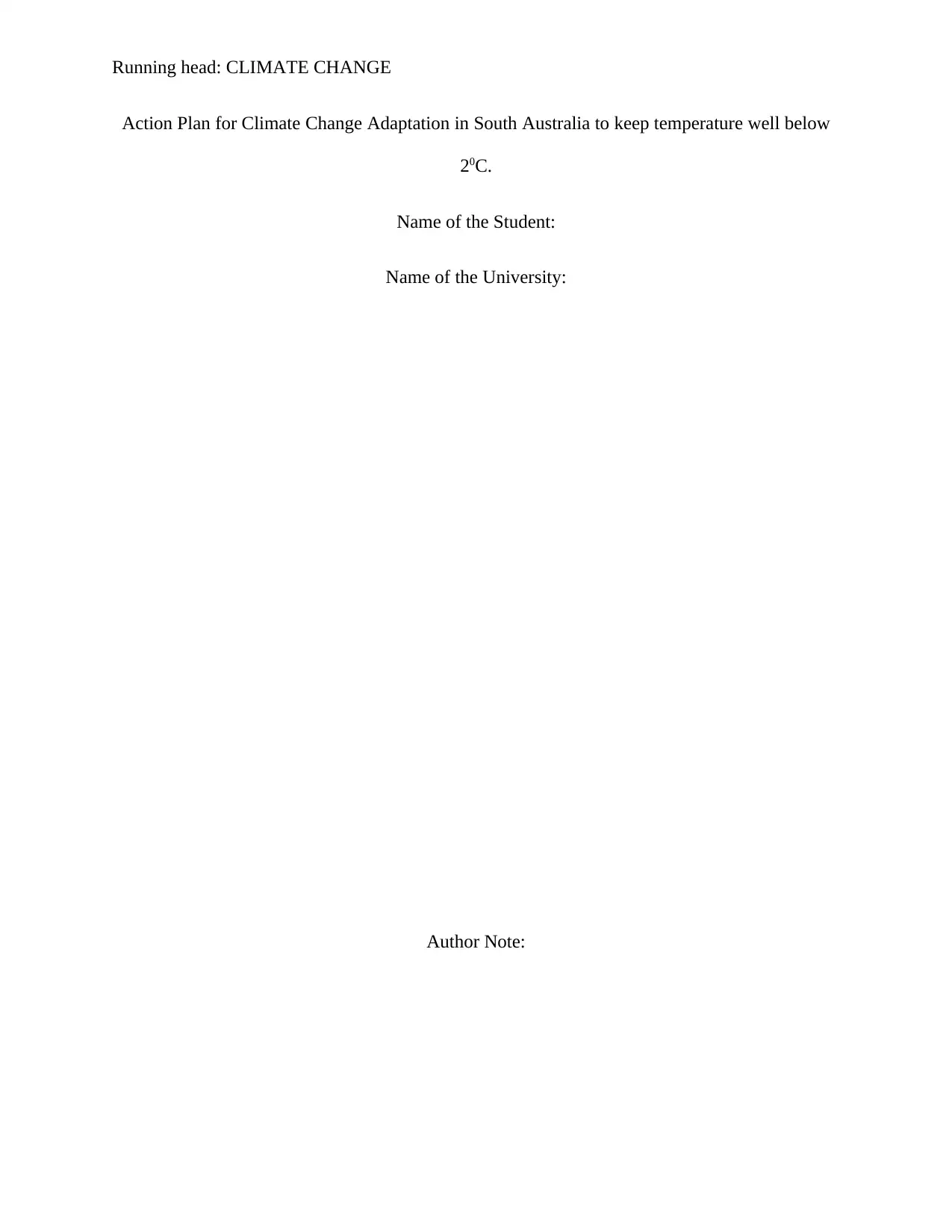
Running head: CLIMATE CHANGE
Action Plan for Climate Change Adaptation in South Australia to keep temperature well below
20C.
Name of the Student:
Name of the University:
Author Note:
Action Plan for Climate Change Adaptation in South Australia to keep temperature well below
20C.
Name of the Student:
Name of the University:
Author Note:
Paraphrase This Document
Need a fresh take? Get an instant paraphrase of this document with our AI Paraphraser
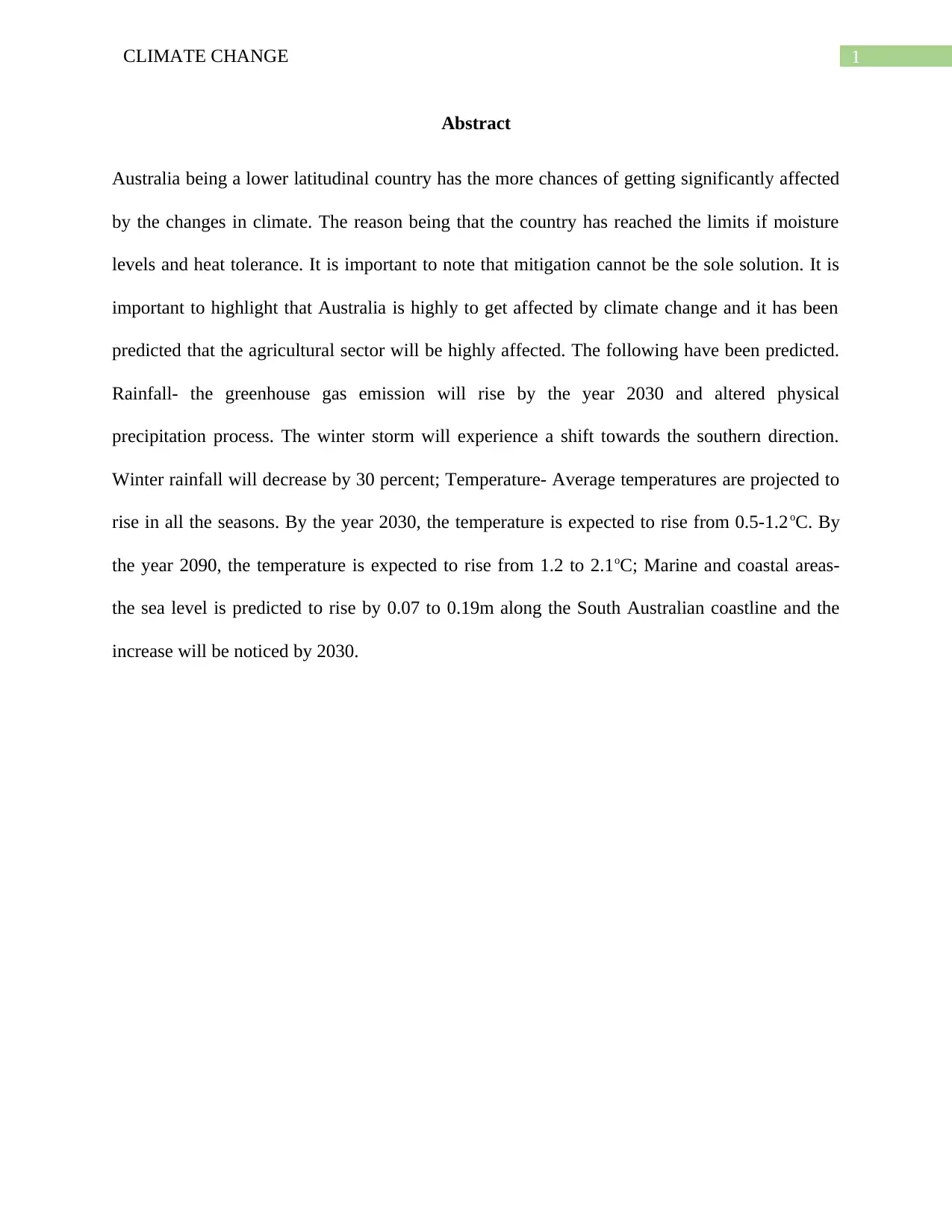
1CLIMATE CHANGE
Abstract
Australia being a lower latitudinal country has the more chances of getting significantly affected
by the changes in climate. The reason being that the country has reached the limits if moisture
levels and heat tolerance. It is important to note that mitigation cannot be the sole solution. It is
important to highlight that Australia is highly to get affected by climate change and it has been
predicted that the agricultural sector will be highly affected. The following have been predicted.
Rainfall- the greenhouse gas emission will rise by the year 2030 and altered physical
precipitation process. The winter storm will experience a shift towards the southern direction.
Winter rainfall will decrease by 30 percent; Temperature- Average temperatures are projected to
rise in all the seasons. By the year 2030, the temperature is expected to rise from 0.5-1.2 oC. By
the year 2090, the temperature is expected to rise from 1.2 to 2.1oC; Marine and coastal areas-
the sea level is predicted to rise by 0.07 to 0.19m along the South Australian coastline and the
increase will be noticed by 2030.
Abstract
Australia being a lower latitudinal country has the more chances of getting significantly affected
by the changes in climate. The reason being that the country has reached the limits if moisture
levels and heat tolerance. It is important to note that mitigation cannot be the sole solution. It is
important to highlight that Australia is highly to get affected by climate change and it has been
predicted that the agricultural sector will be highly affected. The following have been predicted.
Rainfall- the greenhouse gas emission will rise by the year 2030 and altered physical
precipitation process. The winter storm will experience a shift towards the southern direction.
Winter rainfall will decrease by 30 percent; Temperature- Average temperatures are projected to
rise in all the seasons. By the year 2030, the temperature is expected to rise from 0.5-1.2 oC. By
the year 2090, the temperature is expected to rise from 1.2 to 2.1oC; Marine and coastal areas-
the sea level is predicted to rise by 0.07 to 0.19m along the South Australian coastline and the
increase will be noticed by 2030.
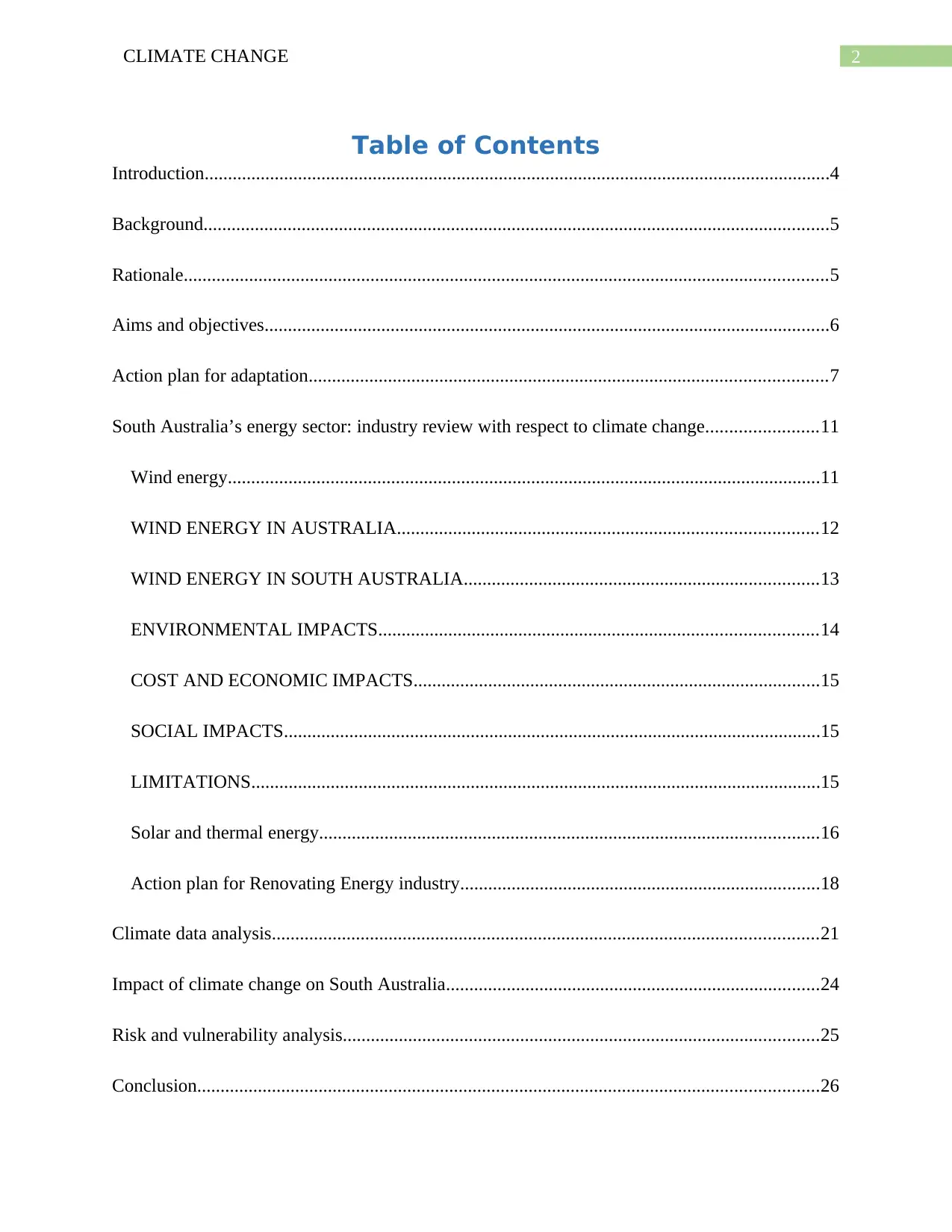
2CLIMATE CHANGE
Table of Contents
Introduction......................................................................................................................................4
Background......................................................................................................................................5
Rationale..........................................................................................................................................5
Aims and objectives.........................................................................................................................6
Action plan for adaptation...............................................................................................................7
South Australia’s energy sector: industry review with respect to climate change........................11
Wind energy...............................................................................................................................11
WIND ENERGY IN AUSTRALIA..........................................................................................12
WIND ENERGY IN SOUTH AUSTRALIA............................................................................13
ENVIRONMENTAL IMPACTS..............................................................................................14
COST AND ECONOMIC IMPACTS.......................................................................................15
SOCIAL IMPACTS...................................................................................................................15
LIMITATIONS..........................................................................................................................15
Solar and thermal energy...........................................................................................................16
Action plan for Renovating Energy industry.............................................................................18
Climate data analysis.....................................................................................................................21
Impact of climate change on South Australia................................................................................24
Risk and vulnerability analysis......................................................................................................25
Conclusion.....................................................................................................................................26
Table of Contents
Introduction......................................................................................................................................4
Background......................................................................................................................................5
Rationale..........................................................................................................................................5
Aims and objectives.........................................................................................................................6
Action plan for adaptation...............................................................................................................7
South Australia’s energy sector: industry review with respect to climate change........................11
Wind energy...............................................................................................................................11
WIND ENERGY IN AUSTRALIA..........................................................................................12
WIND ENERGY IN SOUTH AUSTRALIA............................................................................13
ENVIRONMENTAL IMPACTS..............................................................................................14
COST AND ECONOMIC IMPACTS.......................................................................................15
SOCIAL IMPACTS...................................................................................................................15
LIMITATIONS..........................................................................................................................15
Solar and thermal energy...........................................................................................................16
Action plan for Renovating Energy industry.............................................................................18
Climate data analysis.....................................................................................................................21
Impact of climate change on South Australia................................................................................24
Risk and vulnerability analysis......................................................................................................25
Conclusion.....................................................................................................................................26
⊘ This is a preview!⊘
Do you want full access?
Subscribe today to unlock all pages.

Trusted by 1+ million students worldwide
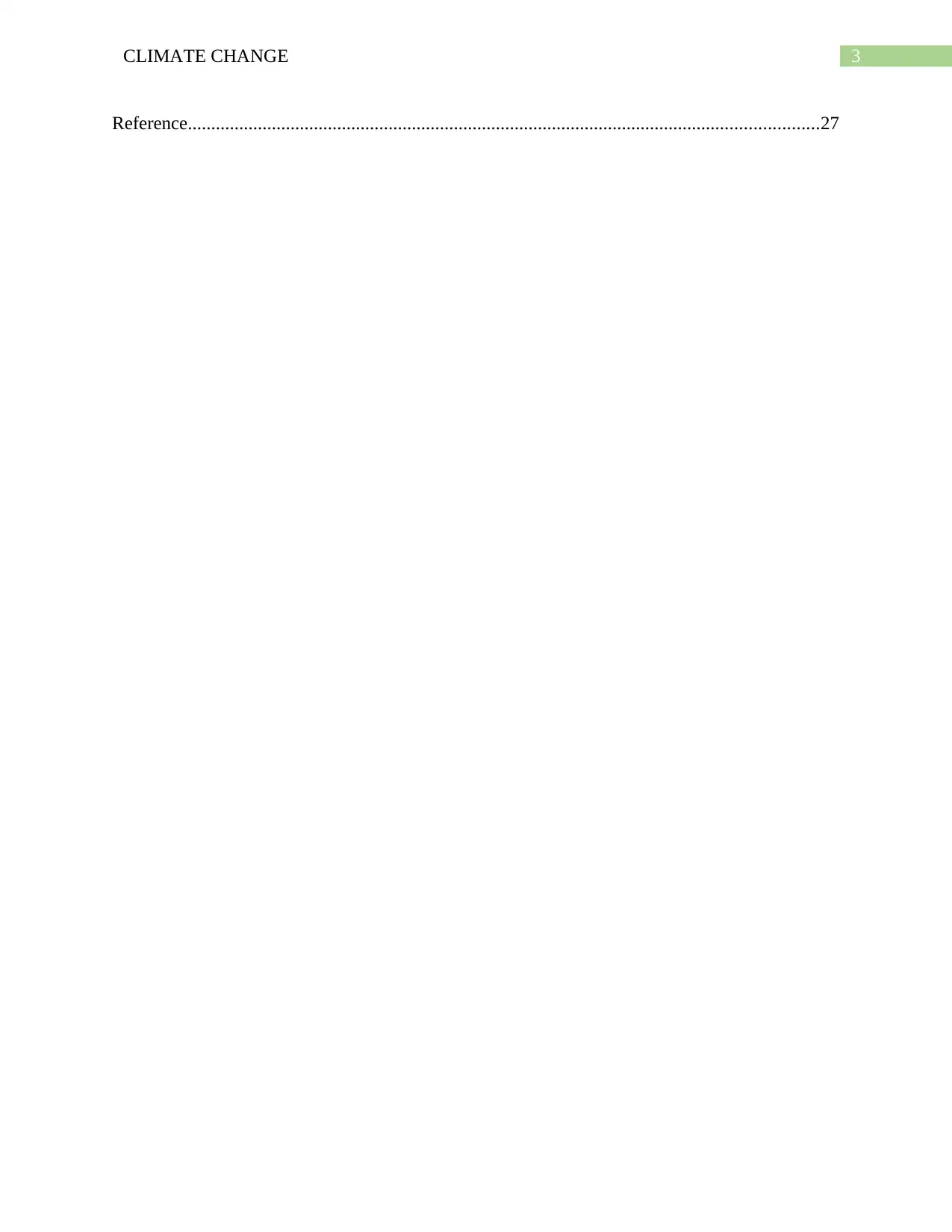
3CLIMATE CHANGE
Reference.......................................................................................................................................27
Reference.......................................................................................................................................27
Paraphrase This Document
Need a fresh take? Get an instant paraphrase of this document with our AI Paraphraser
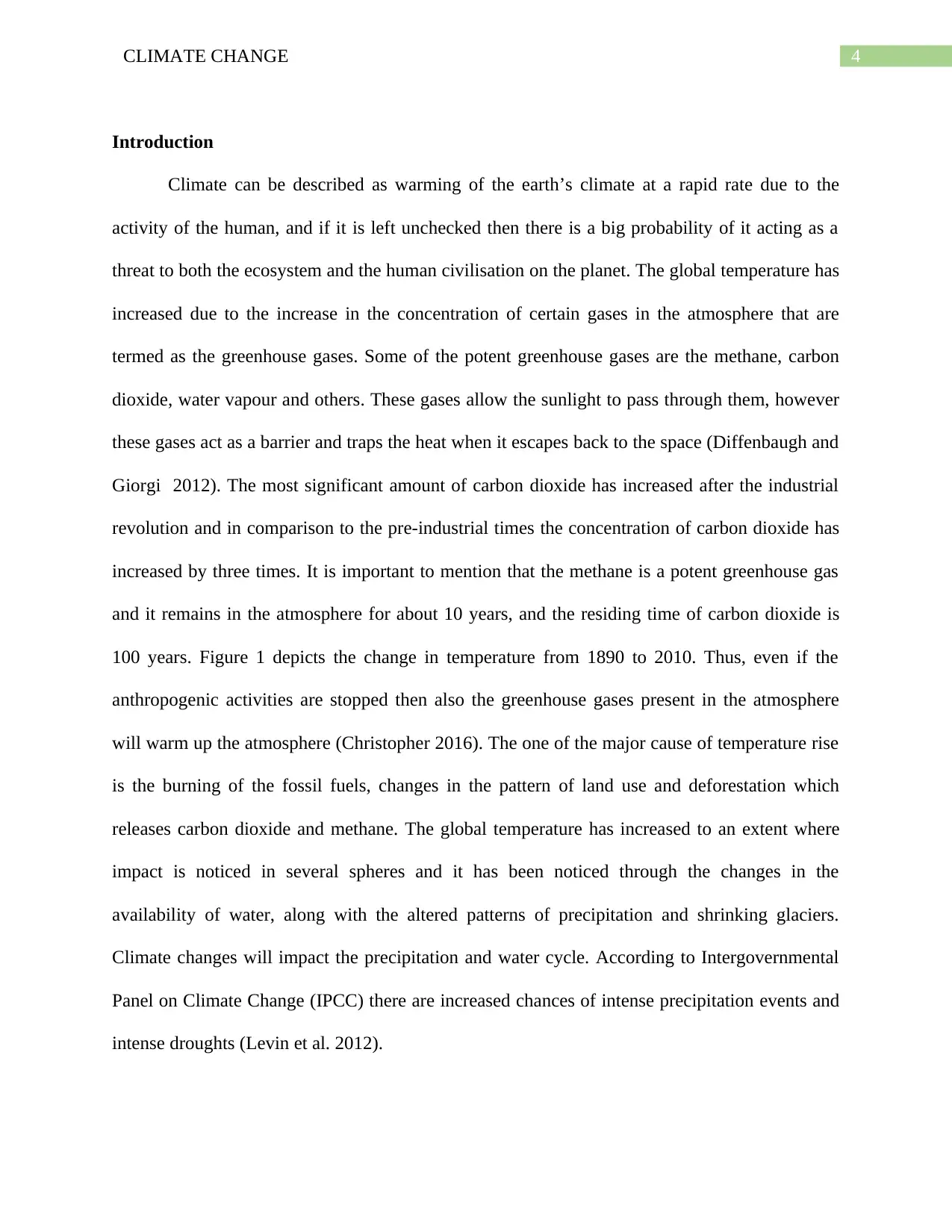
4CLIMATE CHANGE
Introduction
Climate can be described as warming of the earth’s climate at a rapid rate due to the
activity of the human, and if it is left unchecked then there is a big probability of it acting as a
threat to both the ecosystem and the human civilisation on the planet. The global temperature has
increased due to the increase in the concentration of certain gases in the atmosphere that are
termed as the greenhouse gases. Some of the potent greenhouse gases are the methane, carbon
dioxide, water vapour and others. These gases allow the sunlight to pass through them, however
these gases act as a barrier and traps the heat when it escapes back to the space (Diffenbaugh and
Giorgi 2012). The most significant amount of carbon dioxide has increased after the industrial
revolution and in comparison to the pre-industrial times the concentration of carbon dioxide has
increased by three times. It is important to mention that the methane is a potent greenhouse gas
and it remains in the atmosphere for about 10 years, and the residing time of carbon dioxide is
100 years. Figure 1 depicts the change in temperature from 1890 to 2010. Thus, even if the
anthropogenic activities are stopped then also the greenhouse gases present in the atmosphere
will warm up the atmosphere (Christopher 2016). The one of the major cause of temperature rise
is the burning of the fossil fuels, changes in the pattern of land use and deforestation which
releases carbon dioxide and methane. The global temperature has increased to an extent where
impact is noticed in several spheres and it has been noticed through the changes in the
availability of water, along with the altered patterns of precipitation and shrinking glaciers.
Climate changes will impact the precipitation and water cycle. According to Intergovernmental
Panel on Climate Change (IPCC) there are increased chances of intense precipitation events and
intense droughts (Levin et al. 2012).
Introduction
Climate can be described as warming of the earth’s climate at a rapid rate due to the
activity of the human, and if it is left unchecked then there is a big probability of it acting as a
threat to both the ecosystem and the human civilisation on the planet. The global temperature has
increased due to the increase in the concentration of certain gases in the atmosphere that are
termed as the greenhouse gases. Some of the potent greenhouse gases are the methane, carbon
dioxide, water vapour and others. These gases allow the sunlight to pass through them, however
these gases act as a barrier and traps the heat when it escapes back to the space (Diffenbaugh and
Giorgi 2012). The most significant amount of carbon dioxide has increased after the industrial
revolution and in comparison to the pre-industrial times the concentration of carbon dioxide has
increased by three times. It is important to mention that the methane is a potent greenhouse gas
and it remains in the atmosphere for about 10 years, and the residing time of carbon dioxide is
100 years. Figure 1 depicts the change in temperature from 1890 to 2010. Thus, even if the
anthropogenic activities are stopped then also the greenhouse gases present in the atmosphere
will warm up the atmosphere (Christopher 2016). The one of the major cause of temperature rise
is the burning of the fossil fuels, changes in the pattern of land use and deforestation which
releases carbon dioxide and methane. The global temperature has increased to an extent where
impact is noticed in several spheres and it has been noticed through the changes in the
availability of water, along with the altered patterns of precipitation and shrinking glaciers.
Climate changes will impact the precipitation and water cycle. According to Intergovernmental
Panel on Climate Change (IPCC) there are increased chances of intense precipitation events and
intense droughts (Levin et al. 2012).
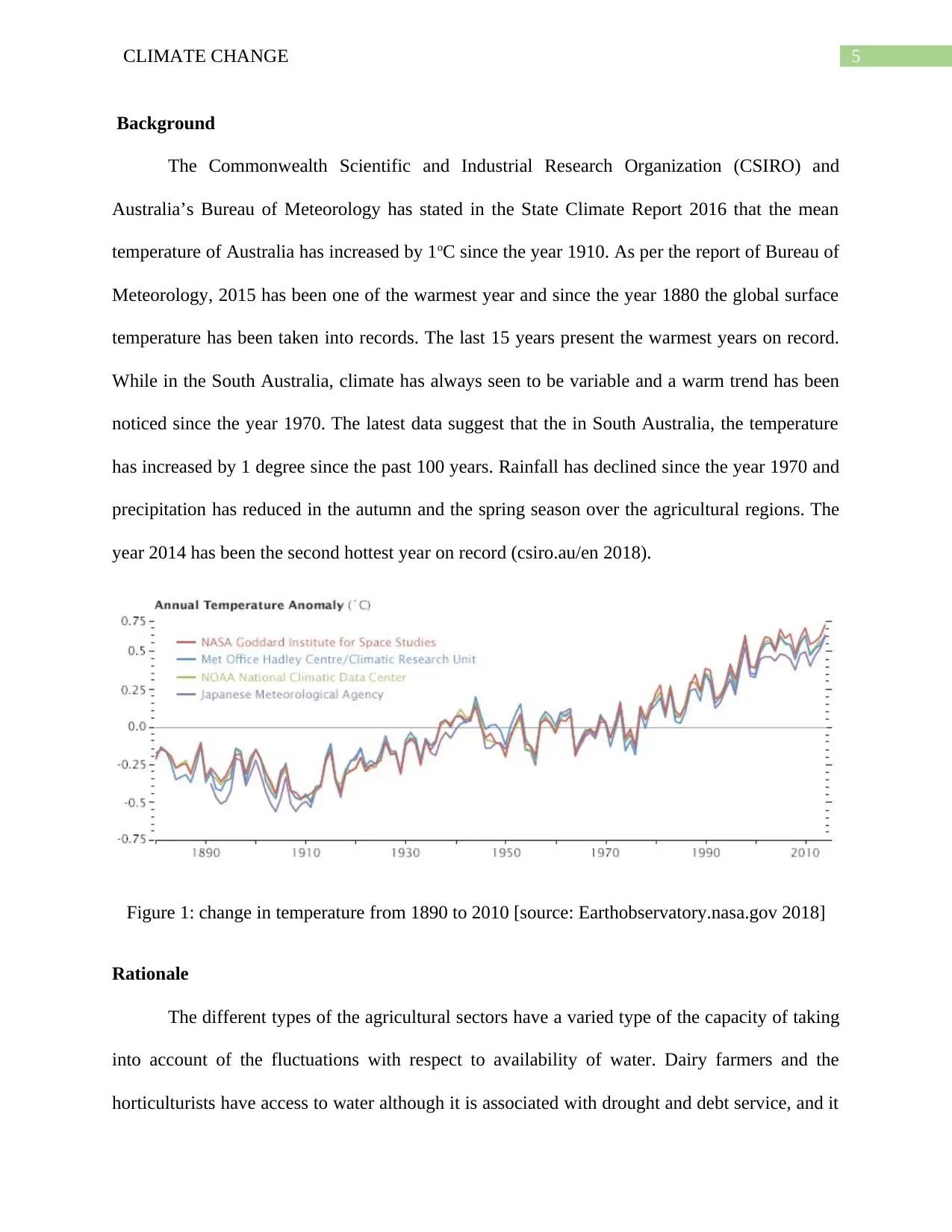
5CLIMATE CHANGE
Background
The Commonwealth Scientific and Industrial Research Organization (CSIRO) and
Australia’s Bureau of Meteorology has stated in the State Climate Report 2016 that the mean
temperature of Australia has increased by 1oC since the year 1910. As per the report of Bureau of
Meteorology, 2015 has been one of the warmest year and since the year 1880 the global surface
temperature has been taken into records. The last 15 years present the warmest years on record.
While in the South Australia, climate has always seen to be variable and a warm trend has been
noticed since the year 1970. The latest data suggest that the in South Australia, the temperature
has increased by 1 degree since the past 100 years. Rainfall has declined since the year 1970 and
precipitation has reduced in the autumn and the spring season over the agricultural regions. The
year 2014 has been the second hottest year on record (csiro.au/en 2018).
Figure 1: change in temperature from 1890 to 2010 [source: Earthobservatory.nasa.gov 2018]
Rationale
The different types of the agricultural sectors have a varied type of the capacity of taking
into account of the fluctuations with respect to availability of water. Dairy farmers and the
horticulturists have access to water although it is associated with drought and debt service, and it
Background
The Commonwealth Scientific and Industrial Research Organization (CSIRO) and
Australia’s Bureau of Meteorology has stated in the State Climate Report 2016 that the mean
temperature of Australia has increased by 1oC since the year 1910. As per the report of Bureau of
Meteorology, 2015 has been one of the warmest year and since the year 1880 the global surface
temperature has been taken into records. The last 15 years present the warmest years on record.
While in the South Australia, climate has always seen to be variable and a warm trend has been
noticed since the year 1970. The latest data suggest that the in South Australia, the temperature
has increased by 1 degree since the past 100 years. Rainfall has declined since the year 1970 and
precipitation has reduced in the autumn and the spring season over the agricultural regions. The
year 2014 has been the second hottest year on record (csiro.au/en 2018).
Figure 1: change in temperature from 1890 to 2010 [source: Earthobservatory.nasa.gov 2018]
Rationale
The different types of the agricultural sectors have a varied type of the capacity of taking
into account of the fluctuations with respect to availability of water. Dairy farmers and the
horticulturists have access to water although it is associated with drought and debt service, and it
⊘ This is a preview!⊘
Do you want full access?
Subscribe today to unlock all pages.

Trusted by 1+ million students worldwide
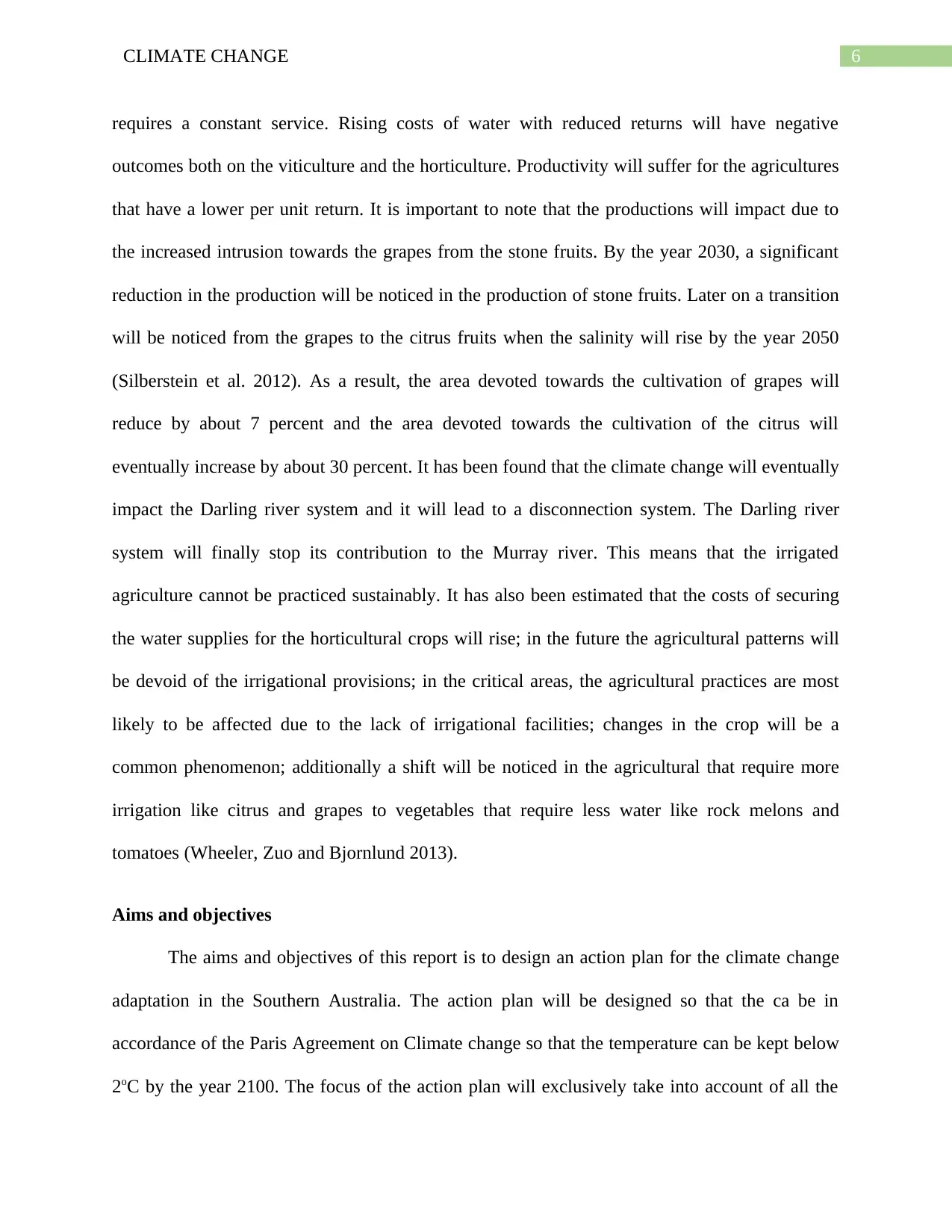
6CLIMATE CHANGE
requires a constant service. Rising costs of water with reduced returns will have negative
outcomes both on the viticulture and the horticulture. Productivity will suffer for the agricultures
that have a lower per unit return. It is important to note that the productions will impact due to
the increased intrusion towards the grapes from the stone fruits. By the year 2030, a significant
reduction in the production will be noticed in the production of stone fruits. Later on a transition
will be noticed from the grapes to the citrus fruits when the salinity will rise by the year 2050
(Silberstein et al. 2012). As a result, the area devoted towards the cultivation of grapes will
reduce by about 7 percent and the area devoted towards the cultivation of the citrus will
eventually increase by about 30 percent. It has been found that the climate change will eventually
impact the Darling river system and it will lead to a disconnection system. The Darling river
system will finally stop its contribution to the Murray river. This means that the irrigated
agriculture cannot be practiced sustainably. It has also been estimated that the costs of securing
the water supplies for the horticultural crops will rise; in the future the agricultural patterns will
be devoid of the irrigational provisions; in the critical areas, the agricultural practices are most
likely to be affected due to the lack of irrigational facilities; changes in the crop will be a
common phenomenon; additionally a shift will be noticed in the agricultural that require more
irrigation like citrus and grapes to vegetables that require less water like rock melons and
tomatoes (Wheeler, Zuo and Bjornlund 2013).
Aims and objectives
The aims and objectives of this report is to design an action plan for the climate change
adaptation in the Southern Australia. The action plan will be designed so that the ca be in
accordance of the Paris Agreement on Climate change so that the temperature can be kept below
2oC by the year 2100. The focus of the action plan will exclusively take into account of all the
requires a constant service. Rising costs of water with reduced returns will have negative
outcomes both on the viticulture and the horticulture. Productivity will suffer for the agricultures
that have a lower per unit return. It is important to note that the productions will impact due to
the increased intrusion towards the grapes from the stone fruits. By the year 2030, a significant
reduction in the production will be noticed in the production of stone fruits. Later on a transition
will be noticed from the grapes to the citrus fruits when the salinity will rise by the year 2050
(Silberstein et al. 2012). As a result, the area devoted towards the cultivation of grapes will
reduce by about 7 percent and the area devoted towards the cultivation of the citrus will
eventually increase by about 30 percent. It has been found that the climate change will eventually
impact the Darling river system and it will lead to a disconnection system. The Darling river
system will finally stop its contribution to the Murray river. This means that the irrigated
agriculture cannot be practiced sustainably. It has also been estimated that the costs of securing
the water supplies for the horticultural crops will rise; in the future the agricultural patterns will
be devoid of the irrigational provisions; in the critical areas, the agricultural practices are most
likely to be affected due to the lack of irrigational facilities; changes in the crop will be a
common phenomenon; additionally a shift will be noticed in the agricultural that require more
irrigation like citrus and grapes to vegetables that require less water like rock melons and
tomatoes (Wheeler, Zuo and Bjornlund 2013).
Aims and objectives
The aims and objectives of this report is to design an action plan for the climate change
adaptation in the Southern Australia. The action plan will be designed so that the ca be in
accordance of the Paris Agreement on Climate change so that the temperature can be kept below
2oC by the year 2100. The focus of the action plan will exclusively take into account of all the
Paraphrase This Document
Need a fresh take? Get an instant paraphrase of this document with our AI Paraphraser
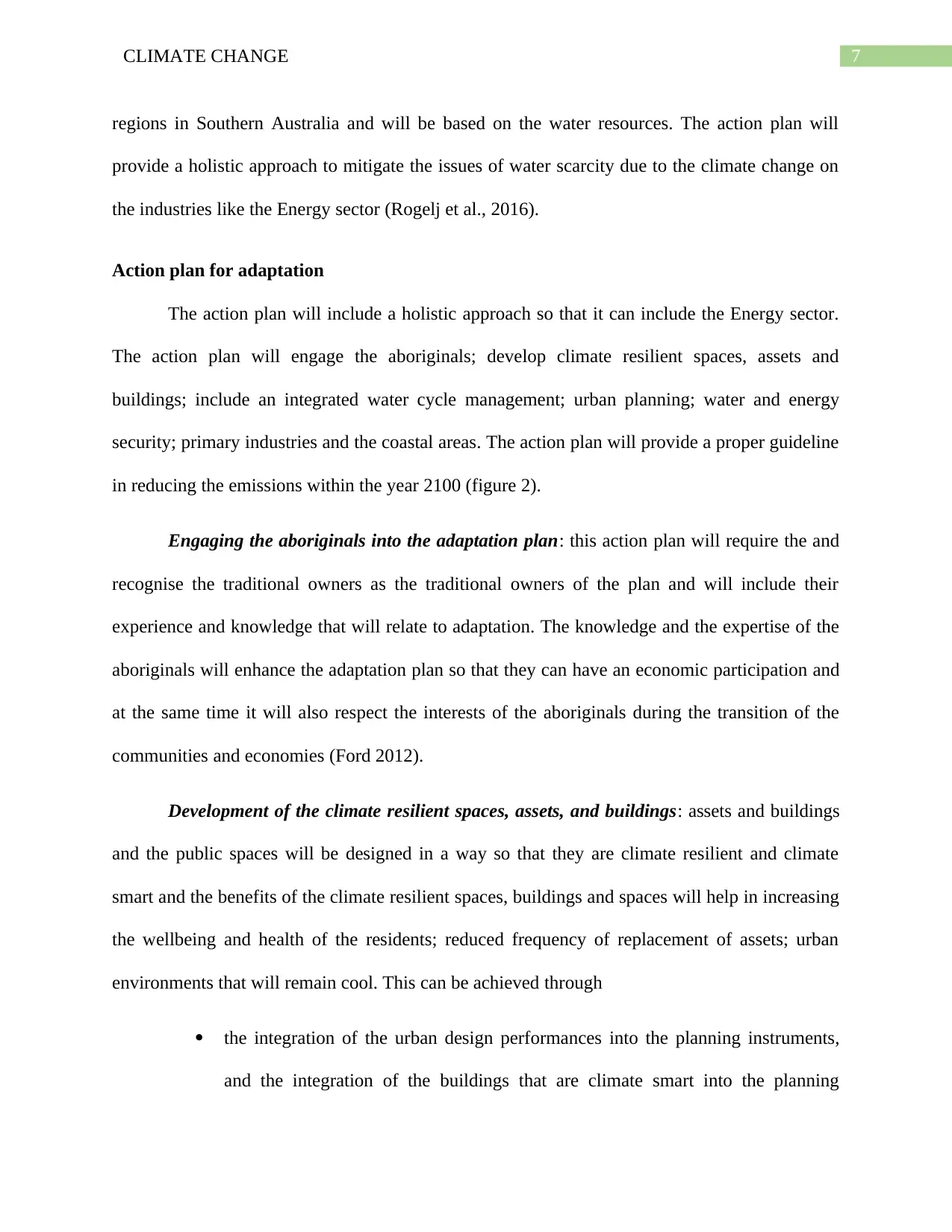
7CLIMATE CHANGE
regions in Southern Australia and will be based on the water resources. The action plan will
provide a holistic approach to mitigate the issues of water scarcity due to the climate change on
the industries like the Energy sector (Rogelj et al., 2016).
Action plan for adaptation
The action plan will include a holistic approach so that it can include the Energy sector.
The action plan will engage the aboriginals; develop climate resilient spaces, assets and
buildings; include an integrated water cycle management; urban planning; water and energy
security; primary industries and the coastal areas. The action plan will provide a proper guideline
in reducing the emissions within the year 2100 (figure 2).
Engaging the aboriginals into the adaptation plan: this action plan will require the and
recognise the traditional owners as the traditional owners of the plan and will include their
experience and knowledge that will relate to adaptation. The knowledge and the expertise of the
aboriginals will enhance the adaptation plan so that they can have an economic participation and
at the same time it will also respect the interests of the aboriginals during the transition of the
communities and economies (Ford 2012).
Development of the climate resilient spaces, assets, and buildings: assets and buildings
and the public spaces will be designed in a way so that they are climate resilient and climate
smart and the benefits of the climate resilient spaces, buildings and spaces will help in increasing
the wellbeing and health of the residents; reduced frequency of replacement of assets; urban
environments that will remain cool. This can be achieved through
the integration of the urban design performances into the planning instruments,
and the integration of the buildings that are climate smart into the planning
regions in Southern Australia and will be based on the water resources. The action plan will
provide a holistic approach to mitigate the issues of water scarcity due to the climate change on
the industries like the Energy sector (Rogelj et al., 2016).
Action plan for adaptation
The action plan will include a holistic approach so that it can include the Energy sector.
The action plan will engage the aboriginals; develop climate resilient spaces, assets and
buildings; include an integrated water cycle management; urban planning; water and energy
security; primary industries and the coastal areas. The action plan will provide a proper guideline
in reducing the emissions within the year 2100 (figure 2).
Engaging the aboriginals into the adaptation plan: this action plan will require the and
recognise the traditional owners as the traditional owners of the plan and will include their
experience and knowledge that will relate to adaptation. The knowledge and the expertise of the
aboriginals will enhance the adaptation plan so that they can have an economic participation and
at the same time it will also respect the interests of the aboriginals during the transition of the
communities and economies (Ford 2012).
Development of the climate resilient spaces, assets, and buildings: assets and buildings
and the public spaces will be designed in a way so that they are climate resilient and climate
smart and the benefits of the climate resilient spaces, buildings and spaces will help in increasing
the wellbeing and health of the residents; reduced frequency of replacement of assets; urban
environments that will remain cool. This can be achieved through
the integration of the urban design performances into the planning instruments,
and the integration of the buildings that are climate smart into the planning
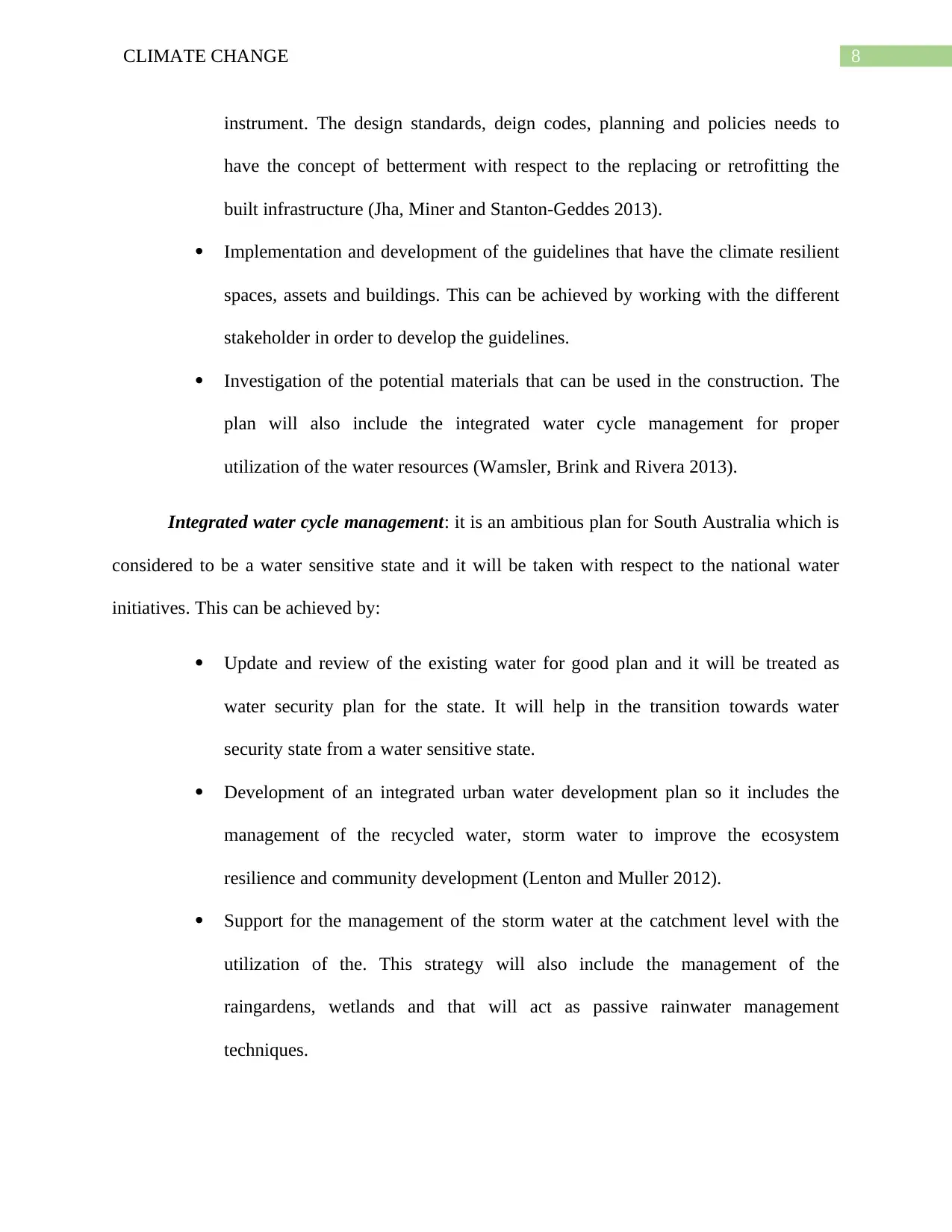
8CLIMATE CHANGE
instrument. The design standards, deign codes, planning and policies needs to
have the concept of betterment with respect to the replacing or retrofitting the
built infrastructure (Jha, Miner and Stanton-Geddes 2013).
Implementation and development of the guidelines that have the climate resilient
spaces, assets and buildings. This can be achieved by working with the different
stakeholder in order to develop the guidelines.
Investigation of the potential materials that can be used in the construction. The
plan will also include the integrated water cycle management for proper
utilization of the water resources (Wamsler, Brink and Rivera 2013).
Integrated water cycle management: it is an ambitious plan for South Australia which is
considered to be a water sensitive state and it will be taken with respect to the national water
initiatives. This can be achieved by:
Update and review of the existing water for good plan and it will be treated as
water security plan for the state. It will help in the transition towards water
security state from a water sensitive state.
Development of an integrated urban water development plan so it includes the
management of the recycled water, storm water to improve the ecosystem
resilience and community development (Lenton and Muller 2012).
Support for the management of the storm water at the catchment level with the
utilization of the. This strategy will also include the management of the
raingardens, wetlands and that will act as passive rainwater management
techniques.
instrument. The design standards, deign codes, planning and policies needs to
have the concept of betterment with respect to the replacing or retrofitting the
built infrastructure (Jha, Miner and Stanton-Geddes 2013).
Implementation and development of the guidelines that have the climate resilient
spaces, assets and buildings. This can be achieved by working with the different
stakeholder in order to develop the guidelines.
Investigation of the potential materials that can be used in the construction. The
plan will also include the integrated water cycle management for proper
utilization of the water resources (Wamsler, Brink and Rivera 2013).
Integrated water cycle management: it is an ambitious plan for South Australia which is
considered to be a water sensitive state and it will be taken with respect to the national water
initiatives. This can be achieved by:
Update and review of the existing water for good plan and it will be treated as
water security plan for the state. It will help in the transition towards water
security state from a water sensitive state.
Development of an integrated urban water development plan so it includes the
management of the recycled water, storm water to improve the ecosystem
resilience and community development (Lenton and Muller 2012).
Support for the management of the storm water at the catchment level with the
utilization of the. This strategy will also include the management of the
raingardens, wetlands and that will act as passive rainwater management
techniques.
⊘ This is a preview!⊘
Do you want full access?
Subscribe today to unlock all pages.

Trusted by 1+ million students worldwide
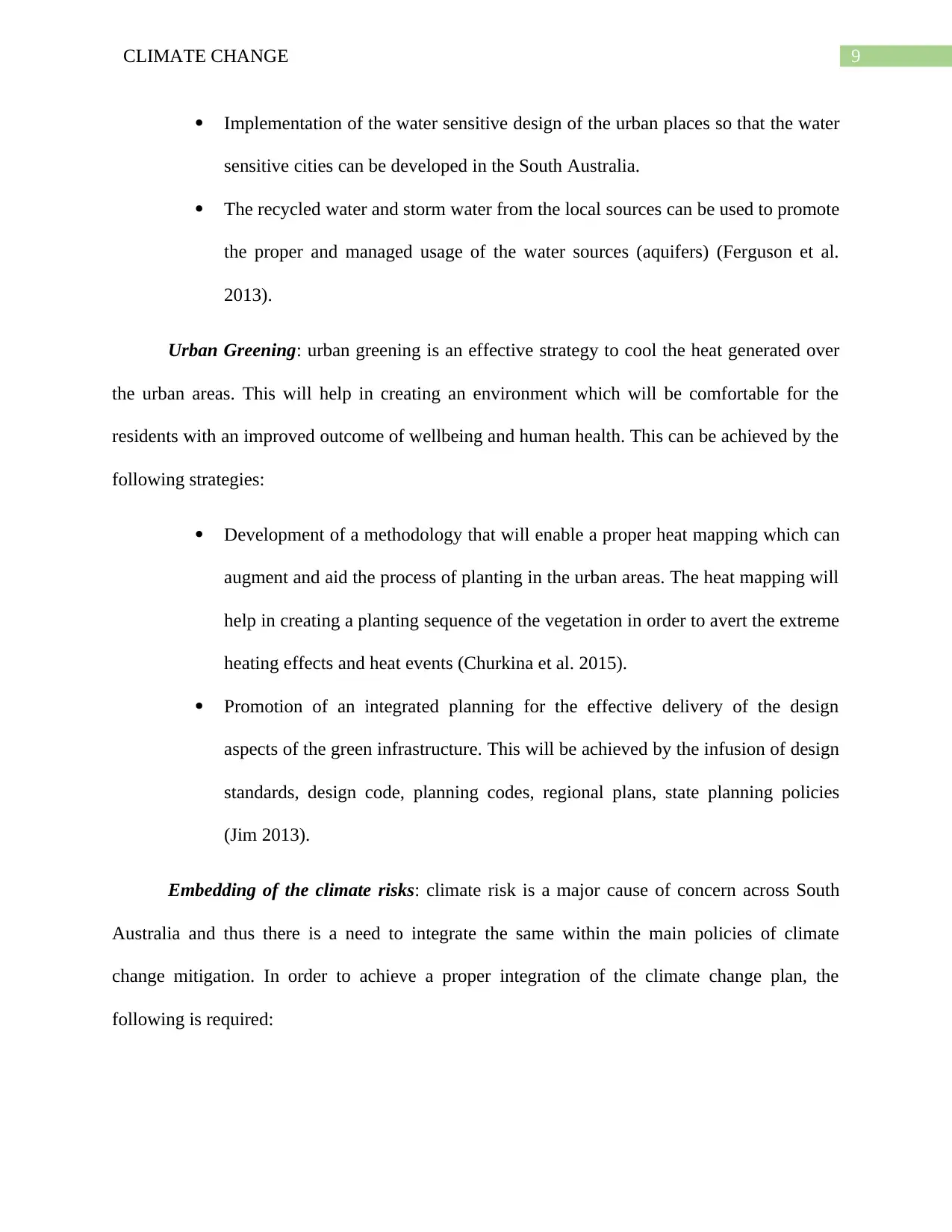
9CLIMATE CHANGE
Implementation of the water sensitive design of the urban places so that the water
sensitive cities can be developed in the South Australia.
The recycled water and storm water from the local sources can be used to promote
the proper and managed usage of the water sources (aquifers) (Ferguson et al.
2013).
Urban Greening: urban greening is an effective strategy to cool the heat generated over
the urban areas. This will help in creating an environment which will be comfortable for the
residents with an improved outcome of wellbeing and human health. This can be achieved by the
following strategies:
Development of a methodology that will enable a proper heat mapping which can
augment and aid the process of planting in the urban areas. The heat mapping will
help in creating a planting sequence of the vegetation in order to avert the extreme
heating effects and heat events (Churkina et al. 2015).
Promotion of an integrated planning for the effective delivery of the design
aspects of the green infrastructure. This will be achieved by the infusion of design
standards, design code, planning codes, regional plans, state planning policies
(Jim 2013).
Embedding of the climate risks: climate risk is a major cause of concern across South
Australia and thus there is a need to integrate the same within the main policies of climate
change mitigation. In order to achieve a proper integration of the climate change plan, the
following is required:
Implementation of the water sensitive design of the urban places so that the water
sensitive cities can be developed in the South Australia.
The recycled water and storm water from the local sources can be used to promote
the proper and managed usage of the water sources (aquifers) (Ferguson et al.
2013).
Urban Greening: urban greening is an effective strategy to cool the heat generated over
the urban areas. This will help in creating an environment which will be comfortable for the
residents with an improved outcome of wellbeing and human health. This can be achieved by the
following strategies:
Development of a methodology that will enable a proper heat mapping which can
augment and aid the process of planting in the urban areas. The heat mapping will
help in creating a planting sequence of the vegetation in order to avert the extreme
heating effects and heat events (Churkina et al. 2015).
Promotion of an integrated planning for the effective delivery of the design
aspects of the green infrastructure. This will be achieved by the infusion of design
standards, design code, planning codes, regional plans, state planning policies
(Jim 2013).
Embedding of the climate risks: climate risk is a major cause of concern across South
Australia and thus there is a need to integrate the same within the main policies of climate
change mitigation. In order to achieve a proper integration of the climate change plan, the
following is required:
Paraphrase This Document
Need a fresh take? Get an instant paraphrase of this document with our AI Paraphraser
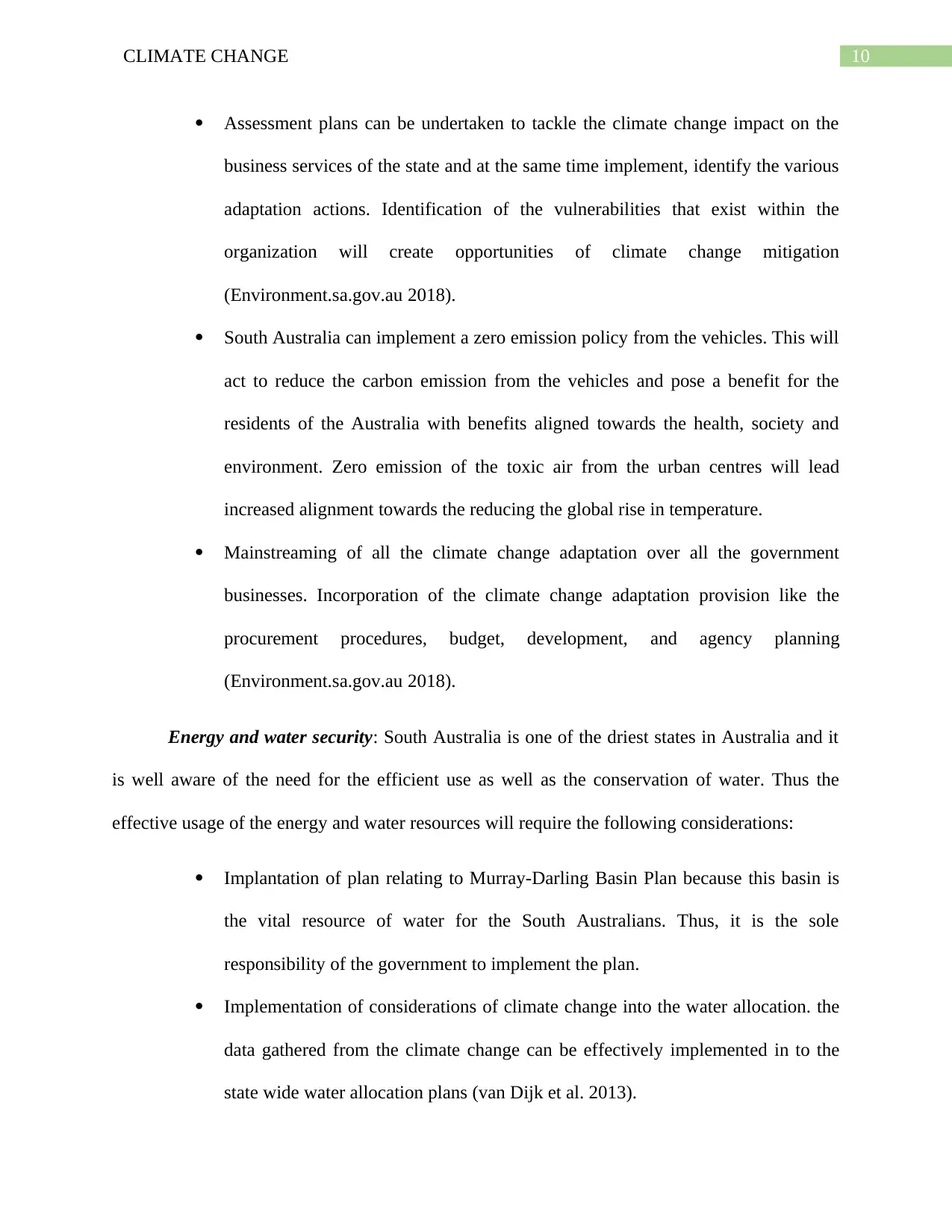
10CLIMATE CHANGE
Assessment plans can be undertaken to tackle the climate change impact on the
business services of the state and at the same time implement, identify the various
adaptation actions. Identification of the vulnerabilities that exist within the
organization will create opportunities of climate change mitigation
(Environment.sa.gov.au 2018).
South Australia can implement a zero emission policy from the vehicles. This will
act to reduce the carbon emission from the vehicles and pose a benefit for the
residents of the Australia with benefits aligned towards the health, society and
environment. Zero emission of the toxic air from the urban centres will lead
increased alignment towards the reducing the global rise in temperature.
Mainstreaming of all the climate change adaptation over all the government
businesses. Incorporation of the climate change adaptation provision like the
procurement procedures, budget, development, and agency planning
(Environment.sa.gov.au 2018).
Energy and water security: South Australia is one of the driest states in Australia and it
is well aware of the need for the efficient use as well as the conservation of water. Thus the
effective usage of the energy and water resources will require the following considerations:
Implantation of plan relating to Murray-Darling Basin Plan because this basin is
the vital resource of water for the South Australians. Thus, it is the sole
responsibility of the government to implement the plan.
Implementation of considerations of climate change into the water allocation. the
data gathered from the climate change can be effectively implemented in to the
state wide water allocation plans (van Dijk et al. 2013).
Assessment plans can be undertaken to tackle the climate change impact on the
business services of the state and at the same time implement, identify the various
adaptation actions. Identification of the vulnerabilities that exist within the
organization will create opportunities of climate change mitigation
(Environment.sa.gov.au 2018).
South Australia can implement a zero emission policy from the vehicles. This will
act to reduce the carbon emission from the vehicles and pose a benefit for the
residents of the Australia with benefits aligned towards the health, society and
environment. Zero emission of the toxic air from the urban centres will lead
increased alignment towards the reducing the global rise in temperature.
Mainstreaming of all the climate change adaptation over all the government
businesses. Incorporation of the climate change adaptation provision like the
procurement procedures, budget, development, and agency planning
(Environment.sa.gov.au 2018).
Energy and water security: South Australia is one of the driest states in Australia and it
is well aware of the need for the efficient use as well as the conservation of water. Thus the
effective usage of the energy and water resources will require the following considerations:
Implantation of plan relating to Murray-Darling Basin Plan because this basin is
the vital resource of water for the South Australians. Thus, it is the sole
responsibility of the government to implement the plan.
Implementation of considerations of climate change into the water allocation. the
data gathered from the climate change can be effectively implemented in to the
state wide water allocation plans (van Dijk et al. 2013).
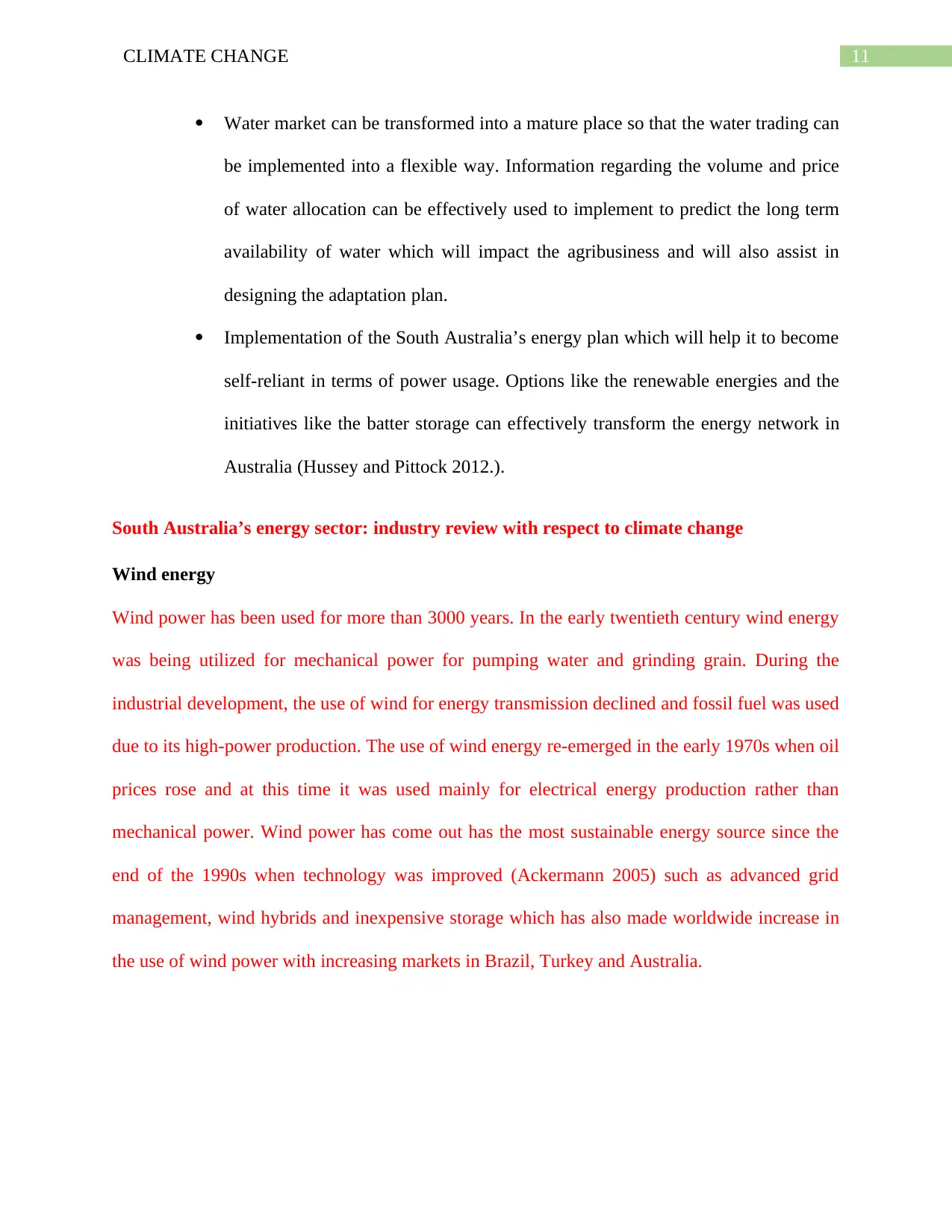
11CLIMATE CHANGE
Water market can be transformed into a mature place so that the water trading can
be implemented into a flexible way. Information regarding the volume and price
of water allocation can be effectively used to implement to predict the long term
availability of water which will impact the agribusiness and will also assist in
designing the adaptation plan.
Implementation of the South Australia’s energy plan which will help it to become
self-reliant in terms of power usage. Options like the renewable energies and the
initiatives like the batter storage can effectively transform the energy network in
Australia (Hussey and Pittock 2012.).
South Australia’s energy sector: industry review with respect to climate change
Wind energy
Wind power has been used for more than 3000 years. In the early twentieth century wind energy
was being utilized for mechanical power for pumping water and grinding grain. During the
industrial development, the use of wind for energy transmission declined and fossil fuel was used
due to its high-power production. The use of wind energy re-emerged in the early 1970s when oil
prices rose and at this time it was used mainly for electrical energy production rather than
mechanical power. Wind power has come out has the most sustainable energy source since the
end of the 1990s when technology was improved (Ackermann 2005) such as advanced grid
management, wind hybrids and inexpensive storage which has also made worldwide increase in
the use of wind power with increasing markets in Brazil, Turkey and Australia.
Water market can be transformed into a mature place so that the water trading can
be implemented into a flexible way. Information regarding the volume and price
of water allocation can be effectively used to implement to predict the long term
availability of water which will impact the agribusiness and will also assist in
designing the adaptation plan.
Implementation of the South Australia’s energy plan which will help it to become
self-reliant in terms of power usage. Options like the renewable energies and the
initiatives like the batter storage can effectively transform the energy network in
Australia (Hussey and Pittock 2012.).
South Australia’s energy sector: industry review with respect to climate change
Wind energy
Wind power has been used for more than 3000 years. In the early twentieth century wind energy
was being utilized for mechanical power for pumping water and grinding grain. During the
industrial development, the use of wind for energy transmission declined and fossil fuel was used
due to its high-power production. The use of wind energy re-emerged in the early 1970s when oil
prices rose and at this time it was used mainly for electrical energy production rather than
mechanical power. Wind power has come out has the most sustainable energy source since the
end of the 1990s when technology was improved (Ackermann 2005) such as advanced grid
management, wind hybrids and inexpensive storage which has also made worldwide increase in
the use of wind power with increasing markets in Brazil, Turkey and Australia.
⊘ This is a preview!⊘
Do you want full access?
Subscribe today to unlock all pages.

Trusted by 1+ million students worldwide
1 out of 32
Related Documents
Your All-in-One AI-Powered Toolkit for Academic Success.
+13062052269
info@desklib.com
Available 24*7 on WhatsApp / Email
![[object Object]](/_next/static/media/star-bottom.7253800d.svg)
Unlock your academic potential
Copyright © 2020–2025 A2Z Services. All Rights Reserved. Developed and managed by ZUCOL.



